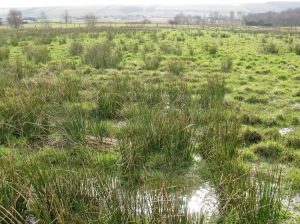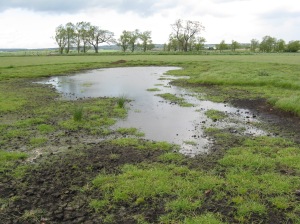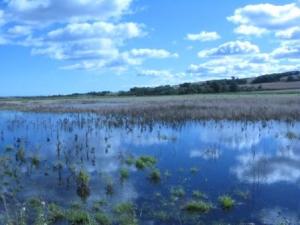Eleven farm sites fell under the umbrella of the Carrs Wetland Project, each being subject to Higher Level Stewardship Agreements which featured wetland options. The majority of these areas (fields) were termed ‘wet grassland’, which means the fields have seasonal wet features in winter until late spring, but tend to dry out in summer and autumn. In total over 2000 hectares of farmland were managed under HLS of which 330 hectares were put into wetland management options.
Below are short profiles of each farm within the project. (Please note that public access is limited to the network of public rights of way, as they are on private land.) As 10-year stewardship agreements, they outlasted the Wetland Project itself which facilitated their creation. Some farm agreements have since been renewed into equivalent land management agreements. The summaries below reflect the situation at the time of the HLS wetland agreements and so may have changed subsequently.
Grove Farm, Cayton
Size of wetland options – 35ha Wet grassland.
This farm, the first in the wetland project starting HLS in 2006, saw 35ha of restored grassland plus substantial areas of game cover. Grove farm plays host to a significant wintering Snipe population. Rushy pasture is managed annually to improve the habitat and encourage Snipe to stay on to nest. More open pastures attract up to 15 breeding pairs of Lapwing. Artificial scrapes dug in 2008 provide feeding opportunities for wader chicks, Yellow Wagtail, and Tree Sparrow. Water vole and Otter have both been encountered on the farm’s network of wet ditches.
Star Carr, Seamer
Size of wetland options 16ha Wet grassland.
Landowner – Scarborough Borough Council
One of the original sites which led to the formation of the Wetland Project, this field has important archaeology where the shore line of ancient Lake Flixton was used by Stone Age humans. This former arable field is now managed as permanent grassland, affording protection to below ground archaeology. It offers habitat for ground nesting birds such as Skylark and Lapwings and has features which flood in the winter and early spring. The wet ditches have botanical interest and signs of Otter activity have been noted.
Carr House Farm, Seamer
 Location – 1Km north of Staxton
Location – 1Km north of Staxton
Size of wetland options – 10ha wet grassland
A small mixed farm with beef cattle, cereals and pasture. Wetland habitats include wet grassland, a pond complex used by Otters and Reed Warblers and some wet woodland in the Flixton Carr Plantation. Carr House Farm supports a good range of farmland birds including Tree Sparrow, Linnet and Reed Bunting. Waders are represented by nesting Lapwing and Curlew plus Whimbrel during passage periods. Over-wintering stubbles are important for Yellowhammers and wild bird crops for Grey Partridge.
Manor Farm, Muston
 Location – parcels of land between Flixton Bridge and Flotmanby Carr
Location – parcels of land between Flixton Bridge and Flotmanby Carr
Size of wetland options – 59ha Wet grassland
This pastoral farm comprised two sites along side the River Hertford, grazed by sheep and cattle. The Muston land abuts Well Springs at the top end of the Hertford. This site is good for Snipe, Yellow Wagtail and Lapwing, benefitting from a system of sluices and in-field scrapes since 2010. The Flixton fields, visible from Flixton Bridge also contain important archaeological sites which were islands in Lake Flixton during the Stone Age.
Potter Brompton Farms, Potter Brompton Carr
 Location – 2km northwest of Ganton
Location – 2km northwest of Ganton
Size of wetland options – 72ha Wet grassland
Restoration of these fields began in 2010 to enhance them for breeding waders. The large programme of scrape creation, and water level management started in September 2010 and began to attract good numbers of waders to nest which include Lapwing, Curlew, and Snipe together with ducks, geese and smaller birds like Yellow Wagtail, Reed Bunting and Linnet. This Farm also has its own website – Potter Brompton Farms including Chris Bradshaw’s blog on ornithological monitoring at the site.
Manor Farm, Willerby Carr
 Location – 2km northwest of Staxton
Location – 2km northwest of Staxton
Size of wetland options – 45ha Wet grassland
Part of a large arable farm, these grassland fields were brought into management for breeding waders including Curlew, Oystercatcher and Lapwing. Naturally wet in winter the breeding habitat was been enhanced by the creation of shallow ‘wader scrapes’ in many fields together with water levels managed by sluices in the spring. Sheep and cattle grazing creates the right habitat for these nesting birds. Other highlights across the whole farm are Willow Tits, Yellow Wagtail and Corn Buntings.
Granary Farm, Folkton
Size of wetland options – 16ha Wet grassland
A small pastoral farm with grazing cattle. This farm joined the project in 2010 and since then 3 sluices installewered and 5 in-field scrapes dug out. This site attracted breeding Lapwing as well as many other birds such as Skylark, Meadow Pipit, Linnet and Reed Bunting. Hares are also regularly spotted here.
Church Farm, Folkton
Size of wetland options – 26ha Wet grassland
A small pastoral farm grazed by cattle. Before signing up for the HLS scheme it was part of the Countryside stewardship scheme for 20 years. The site contained old ditch dams made with railway sleepers and these were upgraded along with additional sluices being installed and scrapes dug out in 2011. These enhancements were targeted at attracting more Lapwing to the area. Other breeding birds that have been seen on the site include Curlew, Skylark, Meadow Pipits and Tree Sparrow.
Lingholm Farm, Lebberston
Size of wetland options – 23.5ha Wet grassland
A large arable farm which contains some peatland fields near to the river which are being restored to wet grassland. To bring this farm into the scheme an arrangement was made whereby the neighbouring farmer, just to the east, would graze his sheep and cattle on the land to manage the HLS grassland. A system of sluices and scrapes were put in place to manipulate the water table. Yellow Wagtail can be found nesting in the arable fields and wintering Snipe have been seen in the wet grassland. Other birds that are benefiting include Lapwing, and Barn Owl.
Grange Farm, Heslerton
Size of wetland options- 10ha Wet grassland
A large arable farm with a variety of crops, where in the winter the ground is grazed by sheep. The wetland site adjoins Potter Brompton Farm. The water table is controlled by sluice systems and a dozen scrapes have been excavated. Mammals such as Roe Deer nad hares have been spotted on this site and farmland birds such as Corn Bunting, Yellow Wagtail and Linnet are frequently seen. This site boasts over 50 pairs of breeding Skylark and 19 pairs of breeding Lapwing. This site is very attractive to migrating birds due to the actions of HLS.
Ings Lane, Staxton
Size of wetland options – 20ha Wet grassland
The last farm to join the Carrs scheme with capital works carried out early spring 2012. A small, mixed farm with permanent pasture on The Carrs, which is grazed by cattle, and cereal crops on Wold land. There are breeding records of Curlew, Lapwing and Oystercatcher on site. The barn on Ings Lane contains built-in nest boxes which are used by a colony of Tree Sparrows as well as larger boxes for Stock Doves and Barn Owl. A remnant of chalk grassland on Staxton Brow is also part of the farm and will be managed to enhance the wildflower species.







